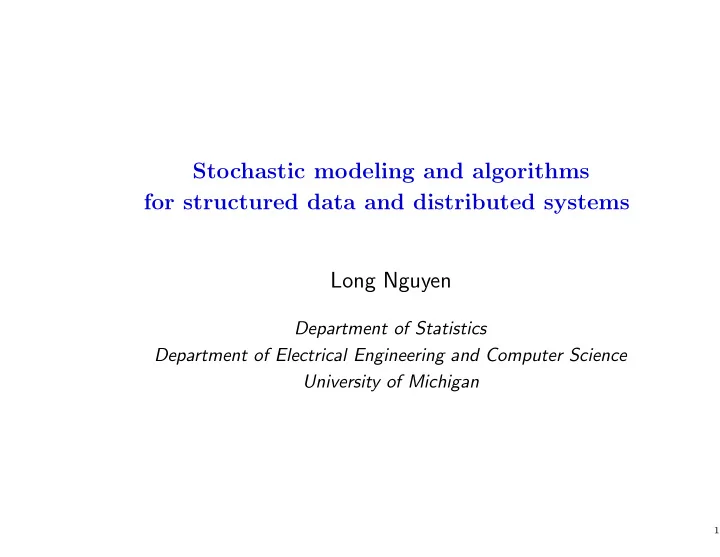

Stochastic modeling and algorithms for structured data and distributed systems Long Nguyen Department of Statistics Department of Electrical Engineering and Computer Science University of Michigan 1
Structured data Data that are rich in contextual information: • time/sequence • space • network-driven • etc (other domain knowledge) 2
Example: Time series signals/curves Progesterone data 6 4 2 log(PGD) 0 −2 −4 −6 −10 −5 0 5 10 15 daily index 3
Example: Multi-mode sensor networks Light source ... ... ... ... sensors • applications: anomaly detection, environmental monitoring 4
Example: Sensors distributed over large geographical area • traffic monitoring and forecast 5
Example: Natural images • image segmentation, clustering, ranking 6
Other data examples we have/are working on • Ecology: forest populations and species compositions in Eastern US – effects of climate change on evolution of species over time and a large geographical area – fine-grained aspects of species competition • Neuroscience: fMRI data of human subjects – activity/connectivity analysis – neurobiological pathways underlying various risk behaviors • Information retrieval: social network data 7
Drawing inference from structured data • the key step for a statistician (machine learner/data miner) is to system- atically translate such known structures into statistically/mathematically rich and yet computationally tractable models – borrow “statistical strengh” from one subpopulation/system/task to learn about other subpopulations/systems/tasks – aggregage statistical strengh across subpopulations to obtain useful, often ”global”, patterns • statistical models provide the right language to describe data, but clever algorithms and data structures are the needed vehicles to help us extract useful patterns 8
Example: “Bag-of-word” model in IR • the structure being exploited here is that the “words” are not independent; moreover, they are exchangeable • de Finetti’s theorem: If the sequence of random variables X 1 , . . . , X n , . . . is infinitely exchangeble, the joint distribution for X 1 , . . . , X n can be expressed by a mixture model: n � � p ( X 1 , . . . , X n ) = p ( X i | θ ) π ( θ ) dθ i =1 for some prior distribution π over θ – θ plays the role of “latent” topics (e.g., probalistic Latent Semantic Indexing model, Latent Dirichlet Allocation model) • mixture modeling strategy extends generally to the very rich hierarchical modeling methodology 9
Beyond exchangeability: injecting spatial/graphical dependence to hierarchical models • exchangeability assumption is useful for uncovering aggregated and global aspects of data – clustering based on latent topics • but not suitable for prediction, extrapolation of local aspects of data – segmentation, part-of-speech tagging • exchangeability assumption is too restrictive in temporal-spatial data, data with non-stationary or asymmetric structures • other modeling tools are available: Markov random fields (a.k.a. prob- ablistic graphical models), multivariate analysis techniques 10
Beyond finite dimensionality: Nonparametric Bayesian methods • in the mixture representation, n � � p ( X 1 , . . . , X n ) = p ( X i | θ ) π ( θ ) dθ. i =1 the latent (topic) variable θ can be taken to be unbounded (infinite di- mensional): As there are more data items, more relevant topics emerge! • the topics can be organized by random and hierarchical structures • learning over these random and potentially unbounded topic hierarchies is very natural using tools from stochastic processes (e.g., Dirichlet processes, Levy processes) 11
Some current works • Dirichlet labeling process mixture model was developed to account for spatial/sequential dependency (Nguyen & Gelfand, 2009) – applied to clustering curves and images, image segmentation • Graphical Dirichlet process mixture model was developed to learn graph- ically dependent clustering distributions (Nguyen, 2010) – connectivity analysis in social networks, and in human brains • A great deal of attention is paid to balancing between statistical richness of model and computational tractability – better sampling algorithms – variational inference motivated from convex optimization 12
Decision-making in data-driven distributed systems • communicational and computational bottleneck • real-time constraints in decision-making • marrying statistical and computational modeling with constraints driven by distributed systems is an exciting challenge in our research agenda 13
Recommend
More recommend